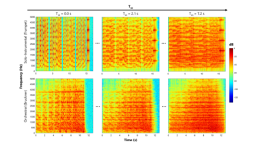Prof. Martin Lawless Co-authors Paper in The Journal of the Acoustical Society of America
POSTED ON: April 3, 2020

IMAGE: (Color online) Spectrograms of a subset of the reverberant stimuli for the solo-instrumental and orchestral motifs from 0 to 5 kHz. Each spectrogram shows the frequency as a function of time with the amplitude (normalized to the peak amplitude across all of the stimuli) denoted by the color scale.
Visiting Professor Martin Lawless has co-authored a paper titled “Sensitivity of the Human Auditory Cortex and Reward Network to Reverberant Musical Stimuli” published in The Journal of the Acoustical Society of America.
ABSTRACT:
A room’s acoustics can alter subjective impressions of music, including preference. However, little research has characterized the brain’s response to room conditions. Functional magnetic resonance imaging (fMRI) was used to investigate the auditory and reward responses to concert hall stimuli. Before the fMRI testing, 18 participants rated their preferences to a solo-instrumental passage and an orchestral motif simulated in eight room acoustic conditions outside an MRI scanner to identify their most liked and disliked conditions. In the MRI, the most-liked (reverberation time, RT¼1.0–2.8 s) and most-disliked (RT¼7.2 s) conditions, along with the [anechoic and scrambled versions] anechoic and scrambled versions of the musical passages were presented. The auditory cortex was found to be sensitive to the temporal coherence of the stimuli as it exhibited stronger activations for simpler stimuli, i.e., the solo instrumental and anechoic conditions, than for stimuli containing temporally incoherent auditory objects—the orchestral and reverberant conditions. In contrasts between liked and disliked reverberant stimuli, a reward response in the basal ganglia was detected in a region of interest analysis using a temporal derivative model of the hemodynamic response function. This response may indicate differences in preference between subtle variations in room acoustics applied to the same musical passage.
Read more here.




